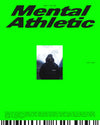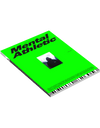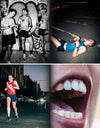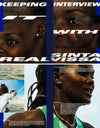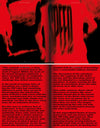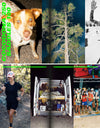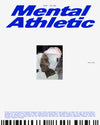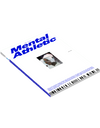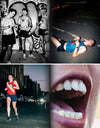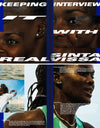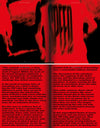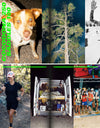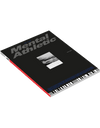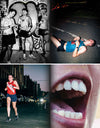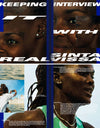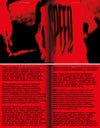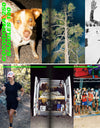INTRO: In 2019, just before the world went into lockdown, Dave Hashim took up running. Amid the pandemic’s trials, he stumbled upon a newfound passion that rekindled an old, almost forgotten one from his childhood—photography. Since then, he has dedicated himself to documenting the evolution of New York City’s running communities and has eagerly embraced the challenges of active movement photography. In the following conversation, Dave delves into his artistic background; his introduction to the running world; the development of New York City’s running crews over the past few years; and the crucial topics of inclusivity, accessibility, and support systems that foster a strong sense of community within these circles.
SHOOTS AND STRIDES
Photo by Dave Hashim | Interview by Chiara Moioli
Q&A:
CHIARA MOIOLI
It’s said that your true calling shows at the point where passion and purpose meet. Can you tell me when, and how, the paths of photography and running crossed in your life, and how your experience as an ultramarathon runner informs your work as a photographer?
DAVE HASHIM
My interest in photography goes a long way back, but my interest in running is relatively new.
Since I was a young child, I always had an interest in cinema and making films. I made a handful of short films on 8 mm and then eventually majored in film in college. My focus was the French New Wave. I loved how organic that movement was in the early days: creators crafting beautiful stories with next to no budget, using only the tools at their disposal.
I tried to make a career out of it, but post-college I was struggling with video freelancing and it just wasn’t sustainable. I stopped creating altogether when I moved to New York City and began working in the business and marketing side of television.
In 2019, I started running for the first time to train for the Chicago Marathon. After the race I fell in love with running, but then COVID-19 hit. I had gotten just enough of a taste of what major marathons and the running community were like, yet I really learned most of what I know about running from doing it solo during the pandemic. On my own, I was exploring parts of NYC I had never been to before.
My relationship with the sport began to change, and my love of running became more focused on movement and exploration instead of medals and finish lines. This idea would eventually influence my photography and my perspective on the distances I run today.
When the world began to open up, I met other runners who were just happy to be running together—training for certain goals for sure, but it was more about camaraderie and community. This was when I picked up the camera again for the first time in about 15 years.
At first, it seemed like an entertaining way to just hang out with my friends and to be close to the sport without actually running myself. On my off days, I’d go out with a camera and shoot as much running as possible. At the start, my images were total garbage, but capturing my friends in the city that I love was a fun challenge. I kept at it, mainly because I was having a good time, shooting almost six to seven days a week, sometimes multiple shoots per day.
Through the sheer volume of shooting, I began to improve quickly. I always approached each shoot with some test for myself, to see if I could truly capture the essence of the moment with genuine emotion. I wanted each image to show the context and environment, and how the runner moving through that environment could alter your perception of the moment. It was a difficult time creatively because I had to dust off an old skill set that I hadn’t thought about in many years. But it all came back to me eventually.
During this same time window, I picked up ultramarathoning by racing the Orchard Street Runners’ OSR30, a 30+ mile unsanctioned race around Manhattan. What I experienced changed how I began approaching running altogether. I only trained for four weeks and found the race itself challenging, but not impossible. It showed me that longer races that combine endurance and exploration were well within my reach. It was at this point that I began to think about how to make both passions a larger part of my life.

CHIARA
What’s the biggest challenge, for you, about working in active movement photography?
DAVE
There are two primary challenges. First, how can I continue to push myself as a creative individual and push boundaries within the field? There are so many creators who have distinct styles and thus certainly no shortage of inspiration, but trying to figure out how to be inspired while remaining authentic to myself and my own style can be tough. My friends and their work also push me to be better. (Shout-out to Keith Montero, Aisha McAdams, Jason Suarez, Margaux le Map, Bilal Aouffen, and Brendan Clarke.)
The second primary challenge is that this type of work can be incredibly taxing on the body and mind. With movement photography, it’s often a physical game just to get yourself in a position to get the shots, whether you’re running with a camera, cycling and shooting from a bike, or working a track meet where you’re on your feet for hours on end. Combine that with the mental portion of composing a decent shot and telling a story. It’s important to me to prep for every shoot as though it were a hard-running workout, and to ensure I have days where I don’t create anything at all—breaks are important for my mental health.
Every time I go out and shoot, I’m putting a small piece of my mental energy into every image. It’s exciting when I get into a flow state on any shoot, where creating feels effortless. It’s a peaceful meditation I only find when I run ultras. On the flip side, when you’re having a tough shoot, it’s incredibly frustrating. Pouring your soul into it and seeing it’s not working can be disappointing; but when it works, there’s nothing more exciting.
CHIARA
How has your journey as a runner in New York been? How have you witnessed the running community in the city evolve over the years? Are there any significant changes or trends you’ve noticed?
DAVE
When I began running, right before everything shut down in 2020, I was very new to it and its culture. I knew almost no one and none of the rich crew running history. When the community became more active in 2021, I started to meet more people and run with more groups across each borough. Each collective run aimed to get as many people across the five boroughs out as possible.
As the number of runners in NYC has grown even further in recent years, I’ve noticed there are more niche clubs and groups that serve specific purposes popping up neighborhood to neighborhood, for those that live nearby and want to experience camaraderie while running. These groups still get anywhere from ten to fifty runners out, but it’s not as massive as it was pre-pandemic. Do you only want to do bridge repeats? There’s a group for that (NBD RC). Are you looking for a cannabis-forward active community? There’s a group for that (Rage & Release). Want to just run on the West Side Highway before work (DBRC)? You get the picture.
There’s nothing like when the full community comes together en masse, it’s a beautiful thing.
CHIARA
In your experience, what role do running clubs play in the growth of a passionate running community?
DAVE
This is a complex answer, mainly because it depends on what the running group is aiming to achieve for its members.
For instance, some clubs and crews are more performance-oriented—take TeamWRK or Brooklyn Track Club (both Brooklyn-based). These are incredible clubs that offer performance training for members of all paces, and help promote the racing focus of the sport. Both groups have an annual membership fee.
With groups like World’s Fair Run Crew (Queens) or Boogie Down Bronx (the Bronx), the focus is more on their communities and staying active through running in their borough. These groups are proud of where they run, and promote their borough identity any chance they get.
Lastly, there are crews like Girls Run NYC or Black Men Run, who aim to create a safe environment to help perpetuate the passion and performance goals their members have for their own personal wellness.
All aim to grow the sport through their own distinct flavor and vibe, and their club/crew leadership focus on providing incredible experiences for the people who come out week in and week out.
CHIARA
Do you perceive any kind of competitiveness inside these circles, as in runners who also perform professionally versus amateurs?
DAVE
There’s natural competition in any sport—it’s part of what makes it sport. What I’ve personally perceived in the last few years is that the NYC running community is the largest support system in the world for any individual looking to better themselves in the sport and in life.
CHIARA
How do you foresee the future of these running circles, particularly when it comes to attentiveness to the discourse of inclusivity?
DAVE
Inclusivity is being talked about more frequently, but where I see it most is at the running club and running crew level. Whenever I talk to leadership in these groups, they’re constantly thinking about how to make their own running group more accessible to all paces and faces.
At the enterprise racing level, and as a person of color myself, I feel the sport still has a long way to go to make everyone feel seen and included. Take the incident from the 2023 Boston Marathon at mile 21, where police prevented Pioneers Run Crew, the only run crew of color on the course, from cheering. There was an outpouring of support from people and clubs across the United States and around the globe, but alternatively those who spoke out about what happened (including myself) saw backlash—which was disheartening, confusing, and angering.
I think strides have been made, but there is a long way to go.

CHIARA
Could you share insights into how communication channels—word of mouth, social media, or other means—have played out in expanding and connecting these groups? Which platforms or methods do you believe have been most effective in fostering this development and sense of belonging?
DAVE
In the digital sphere, it’s all Instagram. It can be frustrating because a unified media outlet for the NYC running community doesn’t really exist, so this means you need to follow more than 50 accounts if you want to stay in the loop with what’s happening.
Because Instagram doesn’t have all the features crews find helpful, some of them have to turn to specific communication platforms for their members, like WhatsApp groups, Geneva, Circle, Heylo, or Slack. This strategy helps crews communicate on upcoming runs, events and also share tips on training and nutrition, further fostering their own sense of community and identity.
Despite the communication challenges of Instagram, there are some circumstances where the platform is actually invaluable for galvanizing community support. The recent WRU Crew 10-Year Anniversary Run is a good example of the community coming out in a big way to celebrate one of the early running crews on the scene. On a more serious note, one of the first Runs to Protest during the pandemic saw groups from all over the city come out to speak up against racial injustice. This support carried through to other groups like Run for Chinatown, during the rise of attacks on Asian individuals in the city. There is a built-in support system in the NYC running community that is alive and well, and it can be accessed on social media.
CHIARA
Are there any particular neighborhoods or routes in New York City that have become popular? What makes these locations special?
DAVE
There are always the classics, like Central Park, Prospect Park, or the West Side Highway up to the Little Red Lighthouse. What’s more interesting to me are the group runs from Manhattan and Brooklyn all the way to Rockaway Beach, which have become more popular throughout the summer. The route itself is not the most pleasant—it’s a high traffic area with little to no shade, but the reward of having a beer and a burger on the beach keeps you going. Shout-out to the OG Jessie Zapo for pioneering the concept at Bridge Runners over a decade ago.
CHIARA
As a photographer, you’ve had the opportunity to document various aspects of New York City’s running scene. Can you share some of your favorite moments or events you’ve captured?
DAVE
Within the community, I’ve seen the highs and lows that come with running; it’s a privilege and a responsibility to have a front row seat to such a rich culture.
Personally, two events come to mind, one being the first marathon I ever photographed—in Rockland State Park just north of NYC, in May 2021. I went up to shoot three friends who were attempting to Boston Qualify or Personal Record. The field was small, and it was a perfect day for a marathon. Maybe it was a simpler time—I wasn’t attached to a brand, I wasn’t shooting for money, I was there to just document my friends achieving their goals.
My second favorite moment was the first Trials of Miles race at Ichan, also in May 2021. It was big, and admittedly, I felt underqualified to shoot. I had only been shooting running consistently for about two months at that point, and there were both runners and shooters whom I admired in attendance. The night itself was perfect, and as the sun began to set, the sky turned crimson. I set aside my insecurities and just shot what came naturally to me. As the night wore on, it felt like there was no other place on the planet I should be. The photos were good, too.



